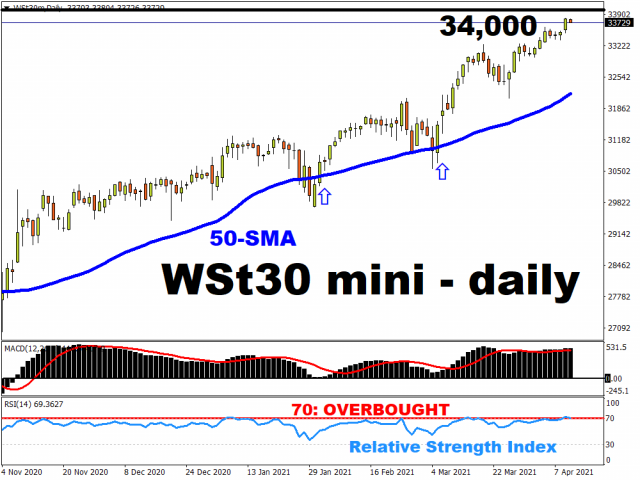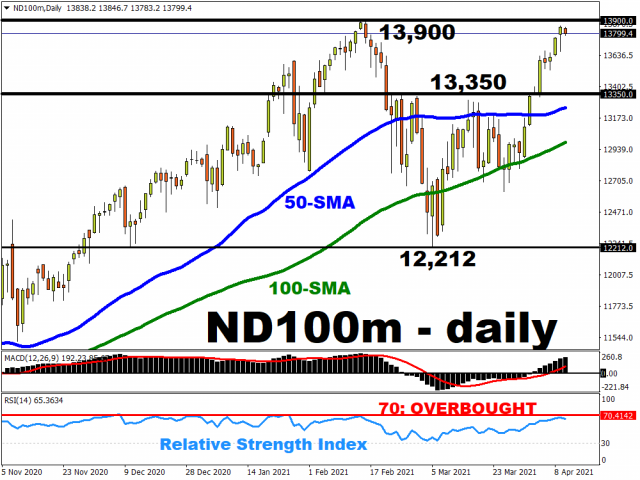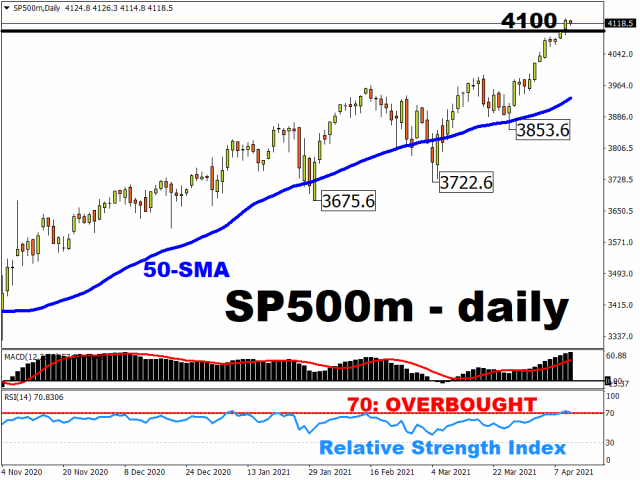By Han Tan Market Analyst, ForexTime
The Dow, S&P 500, and the Nasdaq 100 all posted new record highs last week, although the futures contract for all three benchmark indices are easing slightly at the time of writing. From a technical perspective, such dips are only natural as these assets pull away form overbought territory, as adjudged by their respective 14-day relative strength indexes.
“Markets Extra” Podcast: What is an index and why it matters? A chat with Nasdaq
Last week was also the calmest week for the US stock market so far in 2021, with this past Friday’s trading volume at its lowest since Christmas eve, according to Bloomberg data. Wall Street’s fabled fear gauge, the VIX index, fell to its lowest since February 2020, before the pandemic forced lockdowns across the developed world.
Perhaps the most pressing questions now: how long will this tranquility last, and can these benchmark US indices post fresh record peaks?
Much could depend on the key data and events this week:
Tuesday, April 13
- US consumer price index
Wednesday, April 14:
- Fed Beige Book
- Fed chair Jerome Powell speech
- US earnings season kicks off
Thursday, April 15:
- US retail sales and industrial production
Friday, April 16:
- US consumer sentiment
Inflation expectations still a primary driver of market sentiment
The outlook for US inflation still remains a hot topic for debate.
On one hand, markets expect prices to rise, fueled by the trillions that have been pumped into the economy by the US government and the Federal Reserve. On the other hand, Fed officials have often reiterated their expectations that any burst of inflation is likely to fade away. They have also sought to repeatedly assure the markets that policymakers have the tools to rein in inflationary pressures if they start to do damage to the economic recovery.
With all that in mind, Tuesday’s release of the US March consumer price index is set to be used as the next marker in ascertaining whether markets’ expectations for an inflation overshoot are warranted. Economists expect the month-on-month print to come in at 0.5%, 10 basis points compared to February’s reading. The year-on-year headline CPI is expected to come in at 2.5%, although investors will be cognizant of the low base effect from March 2020.
All that said, a higher-than-expected inflation reading could prompt more selling of US Treasuries, pushing yields higher while triggering volatility in equities. Overvalued tech names stand to lose out in such a scenario, potentially eroding the Nasdaq 100’s month-to-date gains of 5.76%.
Of course, investors will be parsing through all of the key events listed above, and assessing how each of them (Fed Beige Book, Powell’s speech, retail sales, industrial production, consumer sentiment) could fit into the broader narrative surrounding US inflation and the Fed’s policy response.
If markets get the impression that the Fed has got it wrong, and may have to ease up on their asset purchases and raise US interest rates sooner than expected, that could send a jolt across multiple asset classes and dampen the tech stocks party once more.
Earnings season to encourage risk-on mood?
Still, investor sentiment could be buffered by what’s expected to be the highest earnings growth for S&P 500 companies in a decade!
Earnings season kicks off on Wednesday, with financial heavyweights such as JPMorgan, Goldman Sachs, and Wells Fargo reporting their respective quarterly financial results.
According to FactSet, it’s estimated that earnings could grow by 23.8% year-on-year, although the actual figure might be at least 28%. More surprises to the upside could spell further gains for the S&P 500.
The main story around the US stock market remains the US economic recovery. Fed Chair Jerome Powell, in a TV interview that was aired over the weekend, said that the US economy is at an “inflection point” and that “the outlook has brightened substantially”. He also warned of that a resurgence of Covid-19 in the States is a major risk to the economic recovery.
Unless such a negative risk materializes, markets think that the recovery that runs too far too fast could influence the Fed policy outlook, although such a narrative is still subject for interpretation. A massive shift in expectations surrounding the Fed’s policy trajectory, which causes an unruly surge in Treasury yields, could upend the risk-on party. Also, if the inoculation efforts are derailed which dashes the optimism surrounding the US economic recovery, that could warrant a pullback in stocks as well.
Until such things happen, I do expect stocks to continue claiming higher ground over the near-term.
Disclaimer: The content in this article comprises personal opinions and should not be construed as containing personal and/or other investment advice and/or an offer of and/or solicitation for any transactions in financial instruments and/or a guarantee and/or prediction of future performance. ForexTime (FXTM), its affiliates, agents, directors, officers or employees do not guarantee the accuracy, validity, timeliness or completeness, of any information or data made available and assume no liability as to any loss arising from any investment based on the same.
 Article by ForexTime
Article by ForexTime
ForexTime Ltd (FXTM) is an award winning international online forex broker regulated by CySEC 185/12 www.forextime.com



